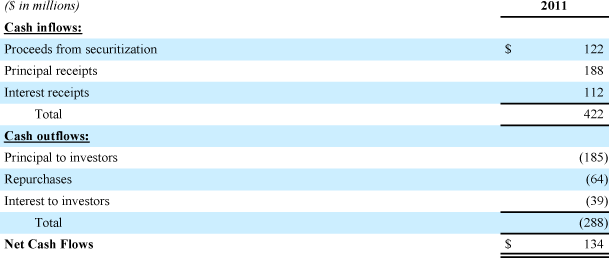 Financial Information
Financial Information
16. VARIABLE INTEREST ENTITIES
Under the applicable accounting guidance for the consolidation of variable interest entities, we analyze our variable interests, including loans, guarantees, and equity investments, to determine if an entity in which we have a variable interest is a variable interest entity. Our analysis includes both quantitative and qualitative reviews. We base our quantitative analysis on the forecasted cash flows of the entity, and our qualitative analysis on our review of the design of the entity, its organizational structure including decision-making ability, and relevant financial agreements. We also use our qualitative analysis to determine if we must consolidate a variable interest entity as its primary beneficiary.
Variable interest entities related to our timeshare note securitizations
Before the spin-off, we periodically securitized, without recourse, through special purpose entities, notes receivable originated by our former Timeshare segment in connection with the sale of timeshare interval and fractional products. These securitizations provided funding for us and transferred the economic risks and substantially all the benefits of the loans to third parties. In a securitization, various classes of debt securities that the special purpose entities issued were generally collateralized by a single tranche of transferred assets, which consisted of timeshare notes receivable. We serviced the notes receivable. With each securitization, we retained a portion of the securities, subordinated tranches, interest-only strips, subordinated interests in accrued interest and fees on the securitized receivables or, in some cases, overcollateralization and cash reserve accounts. As a result of our involvement with these entities in 2011 before the spin-off, we recognized $116 million of interest income, partially offset by $39 million of interest expense to investors and $3 million in debt issuance cost amortization.
We show our cash flows to and from the timeshare notes securitization variable interest entities in the following table for 2011 before the spin-off:

Under the terms of our timeshare note securitizations, we had the right at our option to repurchase defaulted mortgage notes at the outstanding principal balance. The transaction documents typically limited such repurchases to 10 to 20 percent of the transaction’s initial mortgage balance. We voluntarily repurchased $43 million of defaulted notes and $21 million of other non-defaulted notes during 2011.
Other variable interest entities
In the 2013 second quarter, we purchased a $65 million mandatorily redeemable preferred equity ownership interest in an entity that owns three hotels, which we also manage. See Footnote No. 4, “Fair Value of Financial Instruments” for further information on the purchase and Footnote No. 13, “Contingencies” for information on the commitment we entered into as part of this transaction. Based on qualitative and quantitative analyses, we concluded that the entity in which we invested is a variable interest entity because it is capitalized primarily with debt. We did not consolidate the entity because we do not have the power to direct the activities that most significantly impact the entity’s economic performance. Inclusive of our contingent future funding commitment, our maximum exposure to loss at year-end 2013 is $80 million.
In conjunction with the transaction with CTF that we describe more fully in our Annual Report on Form 10-K for 2007 in Footnote No. 8, “Acquisitions and Dispositions,” under the caption “2005 Acquisitions,” we manage hotels on behalf of tenant entities that are 100 percent owned by CTF, which lease the hotels from third-party owners. Due to certain provisions in the management agreements, we account for these contracts as operating leases. At year-end 2013, we managed four hotels on behalf of three tenant entities. The entities have minimal equity and minimal assets, consisting of hotel working capital and furniture, fixtures, and equipment. As part of the 2005 transaction, CTF placed money in a trust account to cover cash flow shortfalls and to meet rent payments. In turn, we released CTF from its guarantees fully for two of these properties and partially for the other two properties. The trust account was fully depleted prior to year-end 2011. The tenant entities are variable interest entities because the holder of the equity investment at risk, CTF, lacks the ability through voting rights to make key decisions about the entities’ activities that have a significant effect on the success of the entities. We do not consolidate the entities because we do not have the power to direct the activities that most significantly impact the entities’ economic performance. We are liable for rent payments (totaling $5 million) for two of the four hotels if there are cash flow shortfalls. These two hotels have lease terms of less than one year. In addition, as of year-end 2013 we are liable for rent payments of up to an aggregate cap of $4 million for the two other hotels if there are cash flow shortfalls. Our maximum exposure to loss is limited to the rent payments and certain other tenant obligations under the lease, for which we are secondarily liable.
